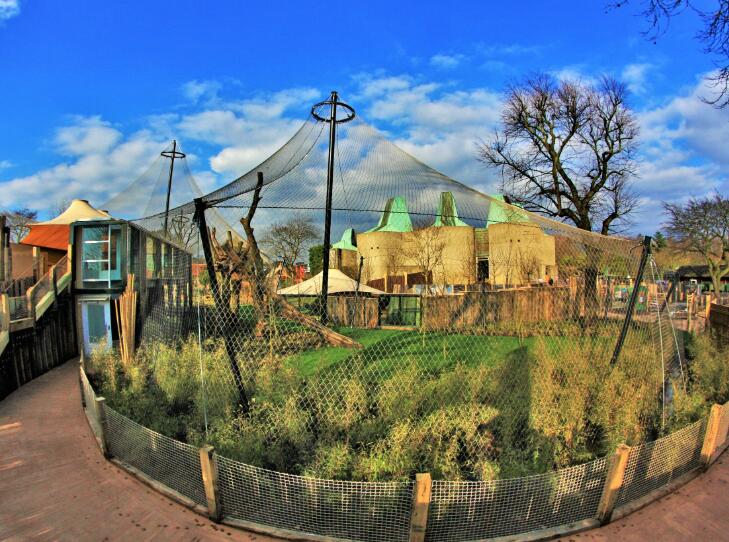Zoo Enclosures: Designing Safe and Comfortable Homes for Animals
When you design a zoo enclosure should consider the following key points ,Zoo enclosures are the homes of animals that are kept in zoos for public viewing and education. These enclosures are designed to provide a safe and comfortable environment for animals while also allowing visitors to observe and learn about them. A well-designed zoo enclosure should be able to meet the physical, social, and emotional needs of the animals it houses.

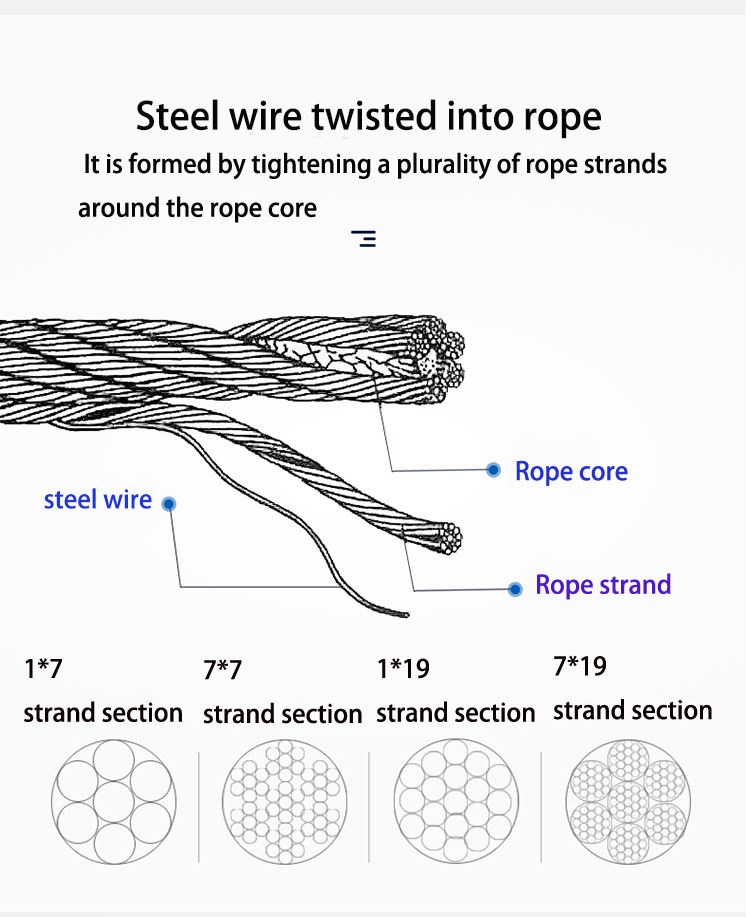
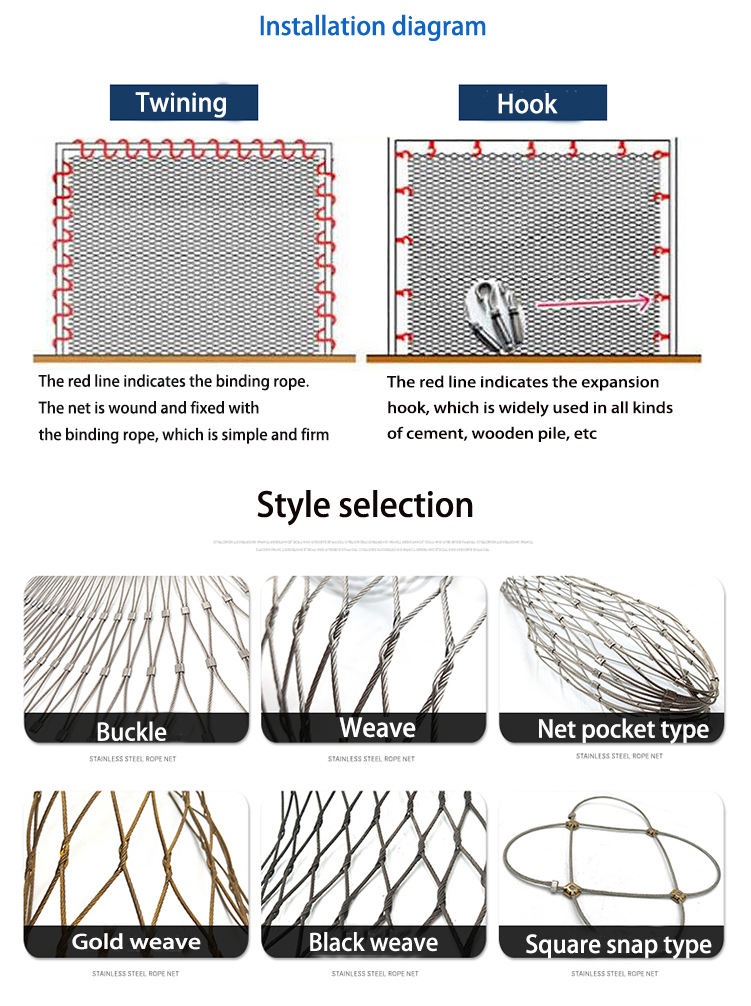
Physical Needs
The physical needs of animals are crucial when designing a zoo enclosure. The enclosure should be large enough to accommodate the animal's natural movements, provide adequate shelter from the elements, and have appropriate substrate (flooring material) for the animal to walk on. In addition, the enclosure should provide access to clean water and a nutritionally balanced diet that meets the animal's dietary requirements.
Social Needs
Many animals are social creatures and require interaction with other animals of their species. The design of the zoo mesh should take into account the social needs of the animals and provide opportunities for social interaction. This can include space for group living and play, as well as areas for animals to retreat when they want to be alone.
Emotional Needs
Animals in zoos may experience stress and anxiety due to their confinement and separation from their natural habitats. To address these emotional needs, zoo enclosures should provide environmental enrichment that mimics the animal's natural habitat, including structures for climbing and hiding, toys, and puzzles. These elements can help stimulate the animal's natural behavior and reduce boredom and frustration.
Safety
Zoo enclosures must be designed with safety in mind. The enclosure should be strong enough to prevent escape, and barriers should be designed to prevent visitors from coming into direct contact with the animals. Additionally, enclosures should be designed to prevent injuries to both animals and visitors.
Sustainability
Zoo enclosures should be designed with sustainability in mind. This includes using materials that are environmentally friendly, conserving water and energy, and minimizing waste. Enclosures should also be designed to minimize the impact on the natural environment.
Conclusion
Zoo enclosures play a vital role in providing a safe and comfortable environment for animals while also allowing visitors to learn about and appreciate them. Designing a zoo enclosure requires careful consideration of the animal's physical, social, and emotional needs, as well as safety and sustainability. By creating well-designed zoo enclosures, we can help protect and conserve wildlife for future generations.
What you should consider before you design or own a zoo enclosure
- Animal species: The enclosure should be designed based on the specific needs of the animal species it will house. The enclosure should provide adequate space, shelter, substrate, and environmental enrichment that mimic the animal's natural habitat.
- Size: The enclosure size should be based on the animal's natural behavior and movement patterns. It should allow the animal to move around freely and have enough space to engage in its natural behaviors.
- Substrate: The enclosure's flooring should be made of materials that are appropriate for the animal species, such as sand, dirt, grass, or rock. The substrate should be easy to clean, and it should be able to provide proper drainage to prevent water from pooling in the enclosure.
- Shelter: The enclosure should provide shelter that is suitable for the animal species. It should provide protection from the elements, such as wind, rain, and extreme temperatures.
- Environmental enrichment: The enclosure should provide environmental enrichment that mimics the animal's natural habitat. This can include structures for climbing, hiding, and perching, as well as toys, puzzles, and other interactive elements.
- Accessibility: The enclosure should be designed to allow for easy access for animal care staff to provide food, water, and other care needs.
- Budget: The enclosure design should take into account the budget available for construction and maintenance of the enclosure.
These specifications can be used as a starting point for designing a zoo enclosure. A more detailed design will require careful consideration of the specific needs of the animal species and the available resources for enclosure construction and maintenance.
General Information zoo enclosure
| Specification | Stainless Steel Cable Mesh | Welded Wire Mesh | Chain Link Mesh |
|---|---|---|---|
| Material | Stainless Steel | Galvanized Steel | Galvanized Steel |
| Wire Diameter | 1.0-3.2mm | 1.0-6.0mm | 1.6-5.0mm |
| Mesh Size | 20x20mm to 200x200mm | 25x25mm to 100x100mm | 25x25mm to 100x100mm |
| Panel Size | Custom sizes up to 30m in length and 3m in height | Standard sizes up to 2.4m in width and 3.0m in height | Standard sizes up to 3.0m in width and 2.4m in height |
| Surface Treatment | Electropolished or passivated | Galvanized or PVC coated | Galvanized or PVC coated |
| Tensile Strength | >1000 N/mm² | Varies depending on wire diameter and mesh size | Varies depending on wire diameter and mesh size |
| Corrosion Resistance | Excellent | Good | Good |
| UV Resistance | Excellent | Good | Good |
| Lifespan | More than 30 years | 10-15 years | 10-15 years |
| Applications | Zoo enclosures, aviaries, animal fences, safety barriers, and more | Zoo enclosures, aviaries, animal fences, and more | Zoo enclosures, animal fences, and more |
Stainless Steel Rope Mesh Details
| Specification | Description |
|---|---|
| Material | Stainless steel 304, 316, or 316L |
| Wire diameter | 1.2mm, 1.6mm, 2.0mm, or 2.4mm |
| Mesh aperture | 20mm x 20mm, 25mm x 25mm, 30mm x 30mm, 35mm x 35mm, or 40mm x 40mm |
| Mesh panel size | Customizable to fit specific project requirements |
| Surface treatment | Electropolished, powder coated, or hot-dipped galvanized |
| Breaking strength | Varies depending on wire diameter and mesh aperture, typically ranges from 1500N to 3000N per wire |
| Mesh shape | Diamond or square |
| Application | Animal enclosures, aviaries, zoo exhibits, architectural and decorative installations, safety barriers, and more |
welded mesh zoo enclosures:
| Specification | Description |
|---|---|
| Material | Galvanized steel or stainless steel |
| Wire diameter | 2.5mm, 3mm, 3.5mm, 4mm, 4.5mm, or 5mm |
| Mesh aperture | 25mm x 25mm, 50mm x 50mm, 75mm x 75mm, or 100mm x 100mm |
| Mesh panel size | Customizable to fit specific project requirements |
| Panel shape | Square or rectangular |
| Panel thickness | 3mm, 3.5mm, 4mm, 5mm, or 6mm |
| Surface treatment | Galvanized or powder coated |
| Application | Animal enclosures, aviaries, zoo exhibits, safety barriers, and more |
chain link zoo enclosures:
| Specification | Description |
|---|---|
| Material | Galvanized steel or stainless steel |
| Wire diameter | 2.0mm, 2.4mm, 2.7mm, 3.0mm, or 3.5mm |
| Mesh aperture | 50mm x 50mm, 60mm x 60mm, 75mm x 75mm, 100mm x 100mm, or 120mm x 120mm |
| Mesh height | Varies depending on the application and animal species, typically ranges from 1.2m to 6m |
| Tensile strength | Varies depending on wire diameter and mesh aperture, typically ranges from 400N to 1200N per wire |
| Surface treatment | Galvanized or PVC coated |
| Application | Animal enclosures, aviaries, zoo exhibits, safety barriers, and more |
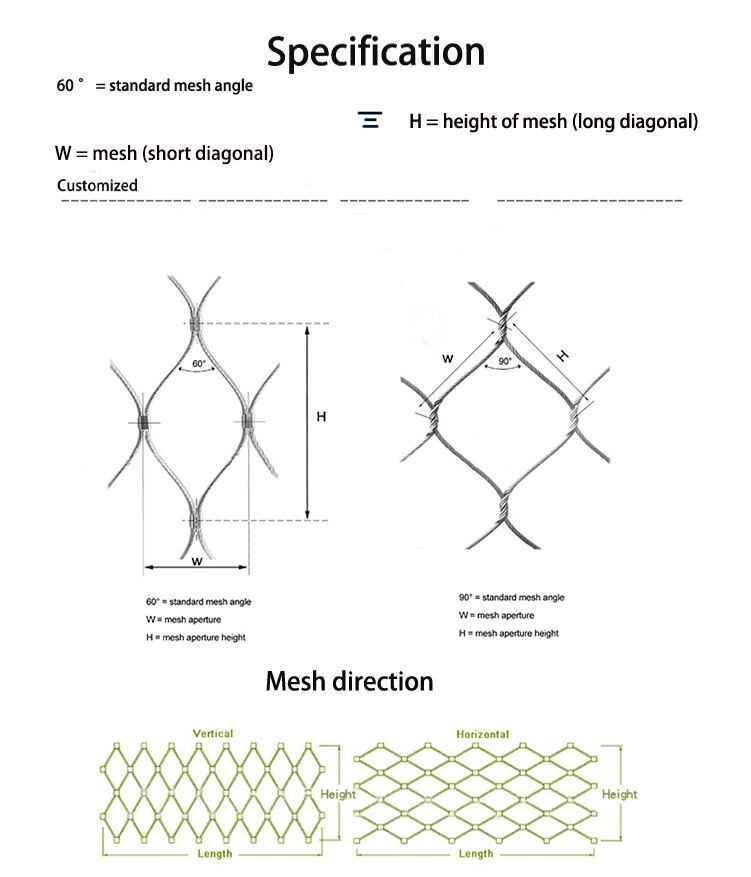
key advantages zoo enclosure include:
- Safe and controlled environment: Zoo enclosures provide a safe and controlled environment for animals, protecting them from predators, disease, and other potential hazards that they may face in the wild.
- Physical and psychological well-being: Zoo enclosures are designed to meet the physical and psychological needs of the animals, providing them with adequate space, food, water, and shelter. This can improve their overall health and well-being.
- Conservation and education: Zoo enclosures can play a vital role in conservation efforts by providing a habitat for endangered or threatened species and promoting public awareness of the need for conservation. Zoos also offer educational opportunities for visitors to learn about animals, their habitats, and the importance of conservation.
- Research: Zoo enclosures can provide a controlled environment for research on animal behavior, health, and ecology. This can lead to important discoveries and advancements in the understanding of animal biology and conservation.
- Entertainment: Zoo enclosures can provide visitors with an entertaining and enjoyable experience, offering an up-close look at animals that may not be seen in the wild.
Overall, properly designed and maintained zoo enclosures can provide many benefits to animals, visitors, and conservation efforts.
The installation of a zoo enclosure will vary depending on the type of enclosure, the materials used, and the specific needs of the animals housed in the enclosure. Here are some general steps that may be involved in installing a zoo enclosure:
-
Site preparation: Clear the site where the enclosure will be installed and level the ground as needed.
-
Foundation and framework: Depending on the type of enclosure, a foundation and framework may need to be installed. This may involve digging holes and pouring concrete or setting steel posts.
-
Mesh installation: Install the mesh material for the enclosure, whether it be welded mesh, chain link, or stainless steel rope mesh. This will typically involve attaching the mesh to the framework or posts using specialized clips, brackets, or ties.
-
Gate installation: Install any gates or entrances to the enclosure, ensuring that they are secure and properly aligned.
-
Finishing touches: Add any finishing touches to the enclosure, such as roofs, shelters, or other structures that may be needed for the specific animal species housed in the enclosure.
-
Safety inspections: Once the enclosure is complete, it's important to conduct safety inspections to ensure that all materials are secure, there are no gaps or openings where animals can escape, and that any features or structures within the enclosure are safe for the animals.
It's important to work with a reputable and experienced installer when installing a zoo enclosure, as they will have the knowledge and expertise to ensure that the enclosure is installed properly and meets all necessary safety standards. Additionally, it's important to consider the specific needs of the animals housed in the enclosure and any regulations or guidelines set by the zoo or relevant authorities.
Packing stainless steel rope mesh zoo enclosure requires some special considerations to ensure that the mesh arrives at its destination in good condition. Here are some general packing tips:
-
Use sturdy packaging: Stainless steel rope mesh is relatively heavy and can be damaged during shipping if not packaged properly. Use a sturdy container, such as a wooden crate or heavy-duty cardboard box, that can withstand the weight and protect the mesh from damage.
-
Wrap the mesh carefully: Before placing the mesh in the container, wrap it carefully in protective material such as bubble wrap or foam padding. This will help prevent scratches or dents during transport.
-
Secure the mesh in the container: Once the mesh is wrapped, make sure it is securely fastened inside the container. Use straps or ropes to hold it in place and prevent it from shifting during transport.
-
Label the container: Clearly label the container with the contents, as well as any special handling instructions. This will help ensure that the package is handled correctly during transport and arrives at its destination on time and in good condition.
-
Consider climate control: Stainless steel is susceptible to corrosion and rusting in certain environments. If you are shipping the mesh to a location with high humidity or other environmental factors that could damage the steel, consider using climate-controlled shipping or special packaging to protect the mesh.
-
Insure the package: Finally, consider insuring the package to protect against loss or damage during transport. This can provide peace of mind and financial protection in the unlikely event that something goes wrong during shipping.
By taking these steps, you can ensure that your stainless steel rope mesh arrives at its destination in good condition and is ready to use.
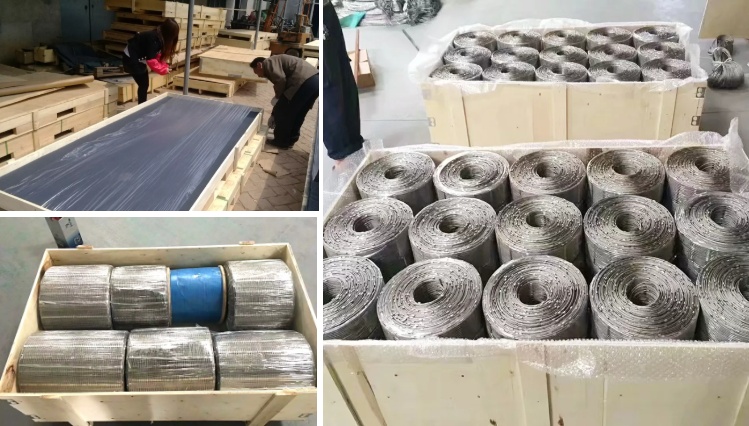
 Boss Metal And Plastic Co Limited
Boss Metal And Plastic Co Limited




